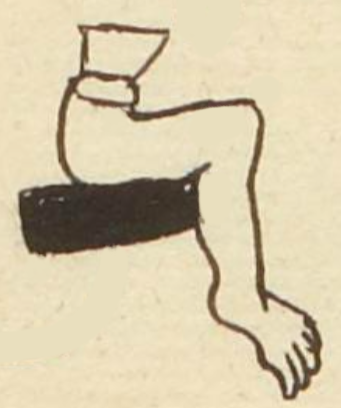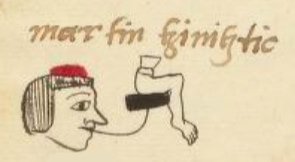Tzinitztic (MH900v)
This black-line drawing of the compound glyph for the personal name Tzinitztic (perhaps “Cold Bottom” or “Bottom Looking”) is attested here as a man’s name. The glyph shows a partial male body with a tiny waist and a focus on the rear end (tzintli). This partial person is sitting on a horizontal obsidian blade (itztli). The belt of a loincloth is the indication that this body is male. The -tic suffix is not shown visually.
Stephanie Wood
The fuller suffix, -itztic, can mean cold. If this is the intention of the name, then the obsidian blade is serving as a phonetic indicator. Another possible interpretation is that the -itztic suffix comes from the verb itztica, to be looking. Either way, however, the itztli serves as a phonetic indicator.
Stephanie Wood
martin tzinitztic
Martín Tzinitztic
Stephanie Wood
1560
Jeff Haskett-Wood
traseros, cuerpos, obsidiana, ver, observar, nombres de hombres

tzin(tli), bottom, rear end, https://nahuatl.wired-humanities.org/content/t
itztic, cold, https://nahuatl.wired-humanities.org/content/itztic
posiblemente, Trasero Frío o Observando Traseros
Stephanie Wood
Matrícula de Huexotzinco, folio 900v, World Digital Library, https://www.loc.gov/resource/gdcwdl.wdl_15282/?sp=873&st=image.
This manuscript is hosted by the Library of Congress and the World Digital Library; used here with the Creative Commons, “Attribution-NonCommercial-ShareAlike 3.0 License” (CC-BY-NC-SAq 3.0).




